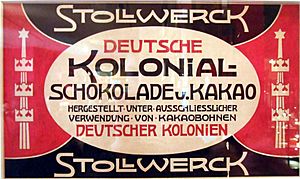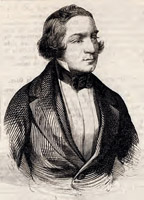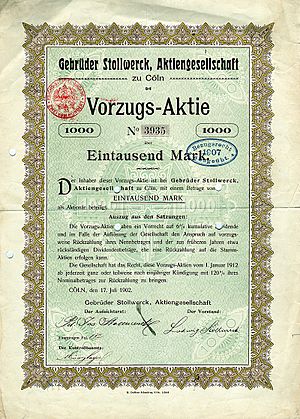Stollwerck facts for kids
| Founded | 1839 in Cologne, Germany |
|---|---|
| Founder | Franz Stollwerck |
| Parent |
|
Stollwerck GmbH is a German company that makes delicious chocolate. It's based in Norderstedt, Germany. The company started way back in 1839 and grew to be a huge international business. It even became the second-largest chocolate maker in the United States by 1900! Stollwerck was owned by Barry Callebaut from 2002 to 2011. Since October 2011, it has been part of a Belgian company called Baronie Group.
Contents
The Sweet History of Stollwerck
How Stollwerck Began
The story of Stollwerck began in 1839 in Cologne, Germany. A baker named Franz Stollwerck started his business. He soon began making chocolate and other candies. His cough drops were especially popular! By 1860, the company was making chocolate, marzipan, and a type of German cookie called printen.
Franz Stollwerck's business grew quickly in Germany. He even opened two coffee houses in Cologne. One of these later became a chocolate and candy factory in the 1860s. After Franz Stollwerck passed away in 1876, his sons took over. They had already started a separate company called Gebrüder Stollwerck (Stollwerck Brothers) in 1871, which then merged back into the original company.
Growing Big with Vending Machines
Stollwerck's five sons helped the business become a huge international company. They opened factories all over Europe and in America. Ludwig Stollwerck, one of the brothers, was very important in bringing in new technology. He helped introduce the first vending machines in 1887.
At first, these machines sold small samples of chocolate. But they became so popular that soon they were selling whole chocolate bars! By 1893, Stollwerck was selling its chocolate in 15,000 vending machines. The company even created separate businesses to make vending machines for other products. These machines sold not just chocolate, but also cigarettes, matches, chewing gum, and soap. For example, they made ticket machines for the Budapest subway, which opened in 1896. By 1890, the Cologne factory alone had 1500 workers.
Reaching Around the World
Stollwerck also focused on selling its products to other countries. They set up companies in England, Belgium, and Austria-Hungary. At the World's Columbian Exposition in Chicago in 1893, they had an amazing display. They built a pavilion (a special building) made from thirty thousand pounds of chocolate and cocoa butter! Inside, there was a ten-foot-tall statue of Germania made of solid chocolate.
In 1894, Stollwerck started a company in the USA called Volkmann, Stollwerck & Company. They partnered with a German businessman, John Volkmann, to make vending machines in a factory in New York. By the late 1890s, there were over 4,000 Stollwerck vending machines in New York train stations. The company also became a top maker of cinematographs, which were early movie projectors. In 1902, the company became public, meaning people could buy shares in it.
By the early 1900s, Stollwerck had offices in many major cities like Berlin, Amsterdam, Brussels, and Chicago. They also had factories in Berlin, Bratislava, London, and New York. Stollwerck even bought other brands, like Dr. Michaelis' Acorn Cacao. They used their many awards and honors to advertise their products. The company's fast growth slowed down when World War I began in 1914.
In 1927, Karl Stollwerck built a special family tomb near Feldkirchen, Upper Bavaria. It was also used for Protestant church services.
In 1928, the Hamburg factory was taken over by another company. Its operations moved to Cologne. In the years that followed, the company was recognized by the government at the time as a "model company."
Challenges and Changes
Expensive purchases and a big economic downturn called the Great Depression caused problems for Stollwerck's money. A bank called Deutsche Bank had to help save the company in the 1930s. This marked the end of the Stollwerck family owning the company. During the Second World War, it was hard to get food and cocoa. This greatly reduced how much chocolate the company could make and sell.
From After the War to Today
After the Second World War, Stollwerck's factories were damaged. Much of their equipment was taken away as war payments. The company started making chocolate again in 1949. They faced a lot of competition in the 1950s and 1960s.
Things got better in 1972 when Hans Imhoff bought the company. He helped Stollwerck become a very successful chocolate maker again. They even competed directly with famous brands like Sarotti. Over the next 30 years, Stollwerck became one of the biggest chocolate makers. They had factories in Germany and other countries. They also took over traditional brands like Sprengel, Sarotti, and Chocolaterie Jacques.
In 1993, the Imhoff-Stollwerck chocolate museum was built in Rheinauhafen, Cologne. It cost a lot of money to build. The museum shows items from Stollwerck's history and teaches about how chocolate is made.
Stollwerck opened a chocolate factory in Székesfehérvár, Hungary, in 1995. They became the top chocolate seller there. They also had great success in Poland and Russia.
In 2001, Hans Imhoff retired. Stollwerck sold its businesses in Eastern Europe to Kraft Foods.
In 2002, Stollwerck was sold to Barry Callebaut AG, which is the world's largest chocolate company. Barry Callebaut then stopped making chocolate at the main factory in Cologne. Only administrative offices stayed there.
In 2006, Barry Callebaut stopped working with the Imhoff-Stollwerck chocolate museum. Lindt & Sprüngli became the museum's new partner. The museum's name changed to Imhoff chocolate museum, and many Stollwerck exhibits were removed.
In October 2011, Barry Callebaut sold Stollwerck to the Baronie Group from Veurne, Belgium. At that time, Stollwerck had five factories in Belgium, Germany, and Switzerland. It had 1700 employees and made about 100,000 tons of chocolate each year. In 2016, after 177 years, the remaining parts of the company moved from Cologne to Norderstedt.
Images for kids
-
The Stollwerck factory in Stamford, Connecticut in 1907.
See also
- Imhoff-Schokoladenmuseum – the Cologne Chocolate Museum
- List of bean-to-bar chocolate manufacturers









